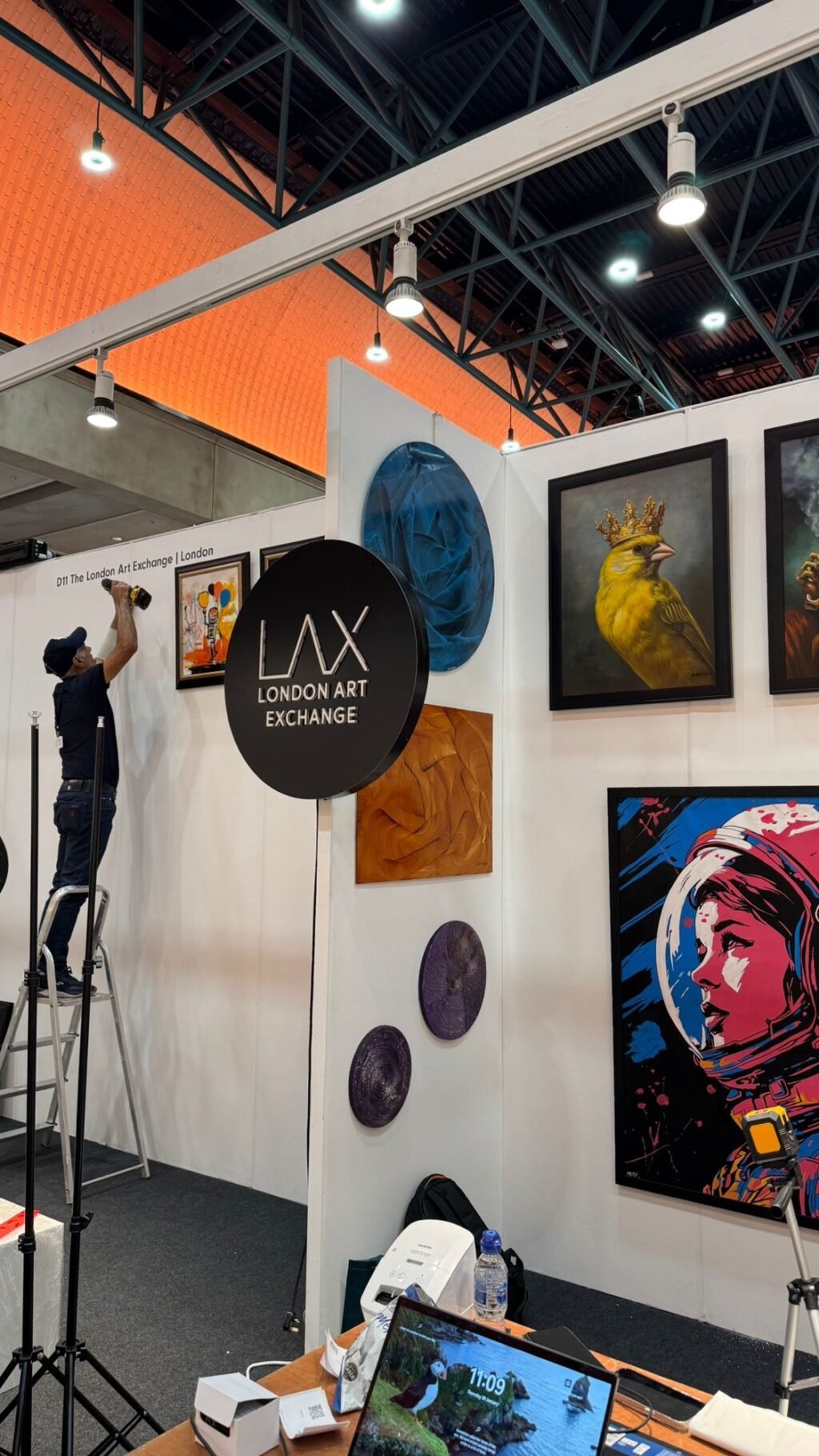By Susan Humphreys, Art Investment Coordinator – artsislife.co.uk
09 July 2025
In a quiet yet unmistakable shift, the UK art market is being reshaped—not by trends, social media hype, or cultural grants, but by demographics.
Over the past six months, I’ve been researching what’s behind the sharp uptick in tangible asset acquisitions, particularly among UK-based investors of Indian and South East Asian heritage. My inquiry began as a general investigation into trends in contemporary art sales. It ended with something much larger: a financial and cultural shift that may be signaling the start of a new asset era.
And at the center of this shift is a Soho Square gallery that’s been quietly outperforming the market with data most institutions don’t even track—London Art Exchange (LAX).
A New Class of Investors Is Emerging
In April 2025, a new report made headlines across UK property and finance circles: British Indians now represent the highest home ownership rate by ethnicity in the UK.
That wasn’t the part that surprised me.
What did surprise me was how that same wealth—a mixture of generational planning, entrepreneurial grit, and cultural prudence—is now moving beyond bricks and mortar into physical, alternative assets.
This includes:
Silver
Whisky
Wine
Art
Gold
Commonly referred to as SWWAG investments, these assets are tangible, transferable, and—most importantly—diverse in their performance cycles compared to traditional markets.
As one investor told me, “You can’t hang Bitcoin on the wall. You can’t hand a Vanguard fund down to your daughter and expect her to love it.”
The Gallery That’s Tracking the Shift
Most galleries I contacted didn’t keep demographic data. Many couldn’t provide client analytics beyond general sales numbers.
London Art Exchange was the exception.
They agreed to provide me with anonymized insights from their Q2 investor report, which covered:
Origins and nationalities of buyers
Average investment size by heritage
Liquidity outcomes for existing clients
Royalty revenue tracking from print releases
Repeat purchase behaviour across portfolios
The data was clear.
43% of all collectors onboarded at LAX between Q1 2024 and Q2 2025 were of Indian heritage
26% were from South East Asian backgrounds
Over 70% had previously invested in gold, property, or whisky
A large portion were first-generation high-net-worth professionals or entrepreneurs
Nearly every single one cited a desire to pass down a legacy asset as a core motivation
These aren’t hobbyist buyers. These are planners. Builders. Architects of long-term financial stewardship.
Where Art Sits Between Gold and Real Estate
This is where it gets interesting.
Using LAX’s five-year historical data (which they allowed me to review under non-disclosure terms), a clear pattern emerged: the value of art investments purchased through their platform correlates closely with the performance of the gold and property markets.
Consider:
In Q2 2023, as UK property growth slowed to under 2%, LAX reported a 17% increase in new Asian investor onboarding
In Q4 2023, following a spike in global gold prices, print-based acquisitions through LAX jumped by 34%
In Q1 2025, just before the Bank of England’s rate hike, high-ticket original sales in the £10,000–£25,000 range surged among Indian and Pakistani investors
This isn’t speculation. It’s strategy.
Physical assets are beginning to move in clusters—and for a savvy investor, that spells opportunity.
What London Art Exchange Is Doing Differently
LAX doesn’t behave like a traditional gallery. Instead, they act more like a financial intermediary for physical art.
Here’s how:
Valuations powered by proprietary AI algorithms (cross-referencing auction results, secondary market data, and trend forecasting)
Royalty models on print editions that provide monthly or quarterly returns
Appraisal-based lending support through affiliated platforms
Exit planning support for collectors wanting to resell strategically
Bespoke portfolio curation based on risk appetite and liquidity needs
They don’t sell “paintings.” They structure “art-backed strategies.”
And the cultural alignment is not accidental. LAX has leaned into what South Asian clients value: discretion, legacy, preservation, and long-term thinking.
The Faces Behind the Works
The artists that South Asian investors are most drawn to?
Gabrielle Malak – Her bold, emotive contemporary series is seen as a rising star investment. One of her early pieces recently appraised at 3x its original 2022 purchase price.
Pierre Simone – The Parisian-Italian graffiti stylist dubbed the “Neo-Basquiat of Europe.” His pieces are popular among next-gen diaspora investors aged 28–40.
Mr. Phantom – The Banksy-esque mystery artist gaining traction through politically charged canvases.
Nitin Ganatra – Former EastEnders actor turned painter. His works explore identity, fatherhood, and dual heritage. All three of his releases sold out within 72 hours.
What unites them? Cultural depth, limited supply, strong resale potential.
The art isn’t being purchased to match a couch. It’s being purchased to build a legacy.
What the Numbers Mean, and What They Don’t
Now, before this is mistaken for a sales pitch—it isn’t.
I am not an art dealer. I am not employed by London Art Exchange. I work independently as an Art Investment Coordinator for artsislife.co.uk, a digital platform that studies market movement in culture-backed investing.
But from what I’ve seen, LAX is the most advanced gallery in the UK when it comes to integrating financial structure with aesthetic value.
They’ve turned artworks into functioning portfolio pieces—without sacrificing artistic integrity.
Not everyone agrees. Some critics argue this approach “commodifies” creativity. But I see it differently. If done ethically, it brings access, accountability, and professionalism to a space that often lacks all three.
The Bigger Picture: Why Outside Investors Are Watching the UK
The global investment community is taking notice.
Several US- and UAE-based fund managers have reportedly approached London-based galleries for data partnerships
Asian family offices are increasingly requesting direct access to UK-based contemporary art dealers
Private equity firms have begun bundling art with other SWWAG assets in luxury index funds
A recent Bloomberg special highlighted LAX’s valuation system as a “future template for gallery operations”
Why the interest?
Because the UK offers something rare: a blend of regulatory stability, cultural depth, and proven asset appreciation—especially in art.
From JMW Turner to Banksy, the UK has shown it knows how to produce and preserve value in the arts. Now, thanks to data-rich platforms like LAX, that tradition is becoming investible—at scale.
Final Thought: This Isn’t Just a Report
If you’re reading this and you’re from a family that already owns property, gold, or a business—you should be paying attention.
Not because art is better. But because art is different.
It’s not taxed the same way
It doesn’t track market volatility
It can’t be copied or faked at scale
And it offers something almost no other asset does: emotional ROI
The data is clear. The movement is real. The time is now.
And for those still sitting on the fence—there’s only one question left:
Will you be watching the shift, or participating in it?
Written by Susan Humphreys, Art Investment Coordinator – artsislife.co.uk
For enquiries or report citations, contact: susan@artsislife.co.uk

